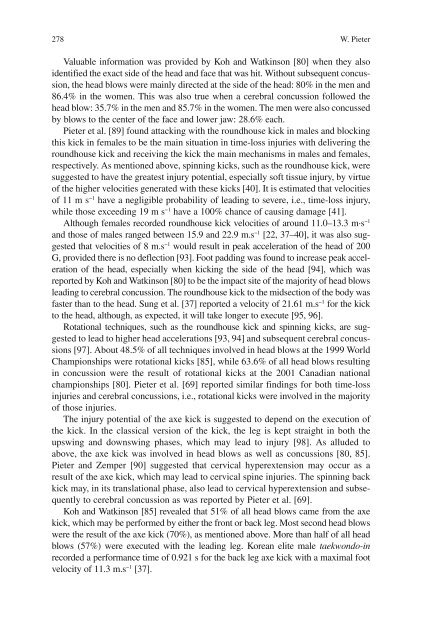Nutrition in Combat Sports
Nutrition in Combat Sports
Nutrition in Combat Sports
Create successful ePaper yourself
Turn your PDF publications into a flip-book with our unique Google optimized e-Paper software.
278 W. Pieter<br />
Valuable <strong>in</strong>formation was provided by Koh and Watk<strong>in</strong>son [80] when they also<br />
identified the exact side of the head and face that was hit. Without subsequent concussion,<br />
the head blows were ma<strong>in</strong>ly directed at the side of the head: 80% <strong>in</strong> the men and<br />
86.4% <strong>in</strong> the women. This was also true when a cerebral concussion followed the<br />
head blow: 35.7% <strong>in</strong> the men and 85.7% <strong>in</strong> the women. The men were also concussed<br />
by blows to the center of the face and lower jaw: 28.6% each.<br />
Pieter et al. [89] found attack<strong>in</strong>g with the roundhouse kick <strong>in</strong> males and block<strong>in</strong>g<br />
this kick <strong>in</strong> females to be the ma<strong>in</strong> situation <strong>in</strong> time-loss <strong>in</strong>juries with deliver<strong>in</strong>g the<br />
roundhouse kick and receiv<strong>in</strong>g the kick the ma<strong>in</strong> mechanisms <strong>in</strong> males and females,<br />
respectively. As mentioned above, sp<strong>in</strong>n<strong>in</strong>g kicks, such as the roundhouse kick, were<br />
suggested to have the greatest <strong>in</strong>jury potential, especially soft tissue <strong>in</strong>jury, by virtue<br />
of the higher velocities generated with these kicks [40] . It is estimated that velocities<br />
of 11 m s −1 have a negligible probability of lead<strong>in</strong>g to severe, i.e., time-loss <strong>in</strong>jury,<br />
while those exceed<strong>in</strong>g 19 m s −1 have a 100% chance of caus<strong>in</strong>g damage [41] .<br />
Although females recorded roundhouse kick velocities of around 11.0–13.3 m·s −1<br />
and those of males ranged between 15.9 and 22.9 m.s −1 [22, 37– 40] , it was also suggested<br />
that velocities of 8 m.s −1 would result <strong>in</strong> peak acceleration of the head of 200<br />
G, provided there is no deflection [93] . Foot padd<strong>in</strong>g was found to <strong>in</strong>crease peak acceleration<br />
of the head, especially when kick<strong>in</strong>g the side of the head [94] , which was<br />
reported by Koh and Watk<strong>in</strong>son [80] to be the impact site of the majority of head blows<br />
lead<strong>in</strong>g to cerebral concussion. The roundhouse kick to the midsection of the body was<br />
faster than to the head. Sung et al. [37] reported a velocity of 21.61 m.s −1 for the kick<br />
to the head, although, as expected, it will take longer to execute [95, 96] .<br />
Rotational techniques, such as the roundhouse kick and sp<strong>in</strong>n<strong>in</strong>g kicks, are suggested<br />
to lead to higher head accelerations [93, 94] and subsequent cerebral concussions<br />
[97] . About 48.5% of all techniques <strong>in</strong>volved <strong>in</strong> head blows at the 1999 World<br />
Championships were rotational kicks [85] , while 63.6% of all head blows result<strong>in</strong>g<br />
<strong>in</strong> concussion were the result of rotational kicks at the 2001 Canadian national<br />
championships [80] . Pieter et al. [69] reported similar f<strong>in</strong>d<strong>in</strong>gs for both time-loss<br />
<strong>in</strong>juries and cerebral concussions, i.e., rotational kicks were <strong>in</strong>volved <strong>in</strong> the majority<br />
of those <strong>in</strong>juries.<br />
The <strong>in</strong>jury potential of the axe kick is suggested to depend on the execution of<br />
the kick. In the classical version of the kick, the leg is kept straight <strong>in</strong> both the<br />
upsw<strong>in</strong>g and downsw<strong>in</strong>g phases, which may lead to <strong>in</strong>jury [98] . As alluded to<br />
above, the axe kick was <strong>in</strong>volved <strong>in</strong> head blows as well as concussions [80, 85] .<br />
Pieter and Zemper [90] suggested that cervical hyperextension may occur as a<br />
result of the axe kick, which may lead to cervical sp<strong>in</strong>e <strong>in</strong>juries. The sp<strong>in</strong>n<strong>in</strong>g back<br />
kick may, <strong>in</strong> its translational phase, also lead to cervical hyperextension and subsequently<br />
to cerebral concussion as was reported by Pieter et al. [69] .<br />
Koh and Watk<strong>in</strong>son [85] revealed that 51% of all head blows came from the axe<br />
kick, which may be performed by either the front or back leg. Most second head blows<br />
were the result of the axe kick (70%), as mentioned above. More than half of all head<br />
blows (57%) were executed with the lead<strong>in</strong>g leg. Korean elite male taekwondo-<strong>in</strong><br />
recorded a performance time of 0.921 s for the back leg axe kick with a maximal foot<br />
velocity of 11.3 m.s −1 [37] .

















